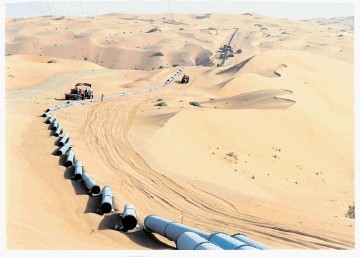
Saudi Arabia is delaying by eight years its target to complete a $109 billion clean-energy program, saying it needs more time to assess what technologies it will use.
The project was originally intended to produce a third of the nation’s electricity from solar panels by 2032 and more power from wind, geothermal and nuclear reactors.
The ambition was to save more crude oil for export.
“We have revised the outlook to focus on 2040 as the major milestone for long-term energy planning in Saudi Arabia,” said Hashim Yamani, president of the King Abdullah City for Atomic and Renewable Energy, the royal agency established to oversee renewable energy policy.
The comments at a conference in Abu Dhabi yesterday are a blow to the kingdom’s effort to feed its rapidly growing population’s demand for more electricity.
The world’s largest oil exporter is having to divert crude supplies for domestic power generation, reducing its main source of income.
King Abdullah’s government set out its ambitions for diversifying its energy supplies in May 2012, the year after an influential Chatham House paper suggested that business-as-usual policies would leave the kingdom a net oil importer by 2038.
The paper by Glada Lahn and Paul Stevens of the London-based research group estimated Saudi Arabia consumes a quarter of its oil production, or 2.8 million barrels a day, for domestic energy needs, and that that the sum will rise as the economy expands.
Saudi Arabia’s population has quadrupled to about 30 million people in the last 40 years.
Its energy consumption is similar to the UK’s, which has double the population, according to the Chatham House paper. Per capita, Saudi Arabia consumes about as much as the US and double Japan’s level, the paper said.
Part of the delay appeared to be linked to the kingdom’s desire to build its own renewable manufacturing business with money from the program.
Currently, most solar panels are made in China, and companies such as General Electric Co. in the US, Siemens AG of Germany and Vestas Wind Systems A/S (VWS) of Denmark make wind turbines.
Saudi Arabia will consume about 129 gigawatts of power by 2032, Yamani said in his speech. The nation wants to be able to build solar plants with 80% of the components made domestically, making it a regional hub for exports of renewable energy technology, he said.
Ka-Care, established by royal decree five years ago, said in 2012 it would seek to build 41 gigawatts of solar power within two decades and another 21 gigawatts of geothermal and wind power.
Currently, a fraction of 1% of the country’s energy supply comes from renewables, with a handful of solar projects producing a few megawatts each.
At the time, Saudi Arabia also said it was working on options to develop its nuclear industry, envisioning 16 reactors by 2030 with a combined capacity of 14 gigawatts.
It signed a nuclear cooperation deal with France and South Korea in 2011 and with China in January 2012.
Saudi Arabia’s effort has helped spur discussion about renewable energy across the Persian Gulf region, with oil producers seeking alternatives to fossil fuels.
Abu Dhabi is already operating one 100-megawatt solar plant, and Dubai last week awarded a contract for a 200-megawatt facility.
Recommended for you
